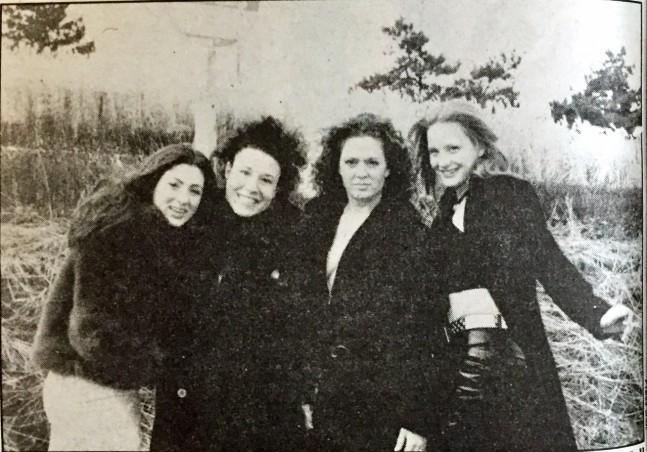RTA students overcome cost barriers to develop high-definition sitcom pilot for class project, networks
By Amy Kenny
The word “hooch” means things — booze, sluts, dogs, pot, a 16th century Dutch painter. People don’t usually associate it with empowerment, but according to radio and television arts student James Johnson, if you adopt it, you own it.
“Hooch” is the title of a new 22-minute sitcom pilot from Sinking Ship Productions — the company formed by fourth-year RTA students Johnson, Blair Powers, Lindsay Everitt, Katie Wilson, Dara Fleischer and Carly Weiner.
Sinking Ship, whose name reminds its founder to stay afloat and focused despite problems, is one of 17 video production groups in the RTA practicum class. Students in this class are responsible for coming up with professional standard production concepts in September, pitching them to faculty advisors, and producing them by March 15. Sinking Ship is one of only two groups using high definition camera this year — a digital format shot on tape to give sharper focus and clarity than regular film. It is a technology so new and expensive, Ryerson has none of the equipment or post-production facilities to process it.
Production proposals ranged from cooking shows, to commercial spots to dramas, to the sitcom pilot for Hooch — Sinking Ship’s edgy comedy about the adventures of five high school girls. The pilot follows them as they skip class one day, determined to get to a hot, new Toronto nightclub called Phallanges. The scenes were shot at Comfort Zone (480 Spadina).
Co-directors and producers Johnson and Powers loosely based the script on the high school escapades of Johnson’s older sister Kami and her friends.
“What we wanted to show was just how much these girls had together, and, as the show progresses, where they all end up,” says Johnson. “None of them regret the crazy things they did — the drugs and the alcohol and the sleeping around. It’s too funny and too surreal. To anyone that hears it, it seems like fiction but the fact that it’s rooted in reality is almost scary.”
The characters are not normal sitcom leads. They’re the girls you find on the fringes of standard TV shows and remember from the smoking pit of your own high school — they live for themselves, answer to no one, and have no regrets.
“For us, Hooch just sort of means the empowerment of these girls that can do anything, that can say anything, that feel they can be anything,” says public relations manager Lindsay Everitt.
“It’s sort of like ‘bitch,’” says Johnson. “It’s how these girls retake that word and use it and they’re going to hooch it up, and they’re hoochie-mama’s, and it just doesn’t matter, because that’s what they are and they love it. They’re five lead girls who make no qualms about what they are to anyone.”
They are deliberately over the top and the humour is intentionally risky — one of the lead characters is under the influence most of the episode. The comfort with which they stir things up is one of the qualities Sinking Ship feels distinguishes its show from typical student projects.
Another aspect that sets Hooch apart is that Sinking Ship put $6,000 of its own money toward the budget, to film a sitcom Johnson says should have cost $200,000.
They were so enthusiastic about using high-definition cameras, that William F. White Limited, a Toronto equipment house, supplied the gear and deferred the cost in exchange for sponsor credit and an invitation to the screening of Hooch.
“Deferring our costs is a nice way of saying we do not have to pay anything, ever,” says Everitt. “Call it a loan if you will. The companies that we worked with were, simply, generous.” Powers thinks the team’s passion for Hooch, and persistence in bargaining, helped gain this backing.
“We had so much support from the most bizarre places,” says Everitt. “We were pretty shameless at times. I mean, we needed a lot of help and no was just not an option.”
This determination helped get Kids in the Hall’s Mark McKinney to join the cast as the hooches’ guidance counsellor in a flashback scene. When McKinney was in Toronto, doing Fully Committed at the Elgin and Winter Garden Theatre in November, Sinking Ship approached him with the role.
Ready or Not’s Lani Billard plays one of the leads, and David Bronstein, of late night infomercial fame, actually called them for a part.
Johnson says because there is such demand for high-definition work, its use creates a buzz in the production industry. Actors worked on Hooch for free because it adds a professional quality show to portfolios, and crewmembers from William F. White volunteered their time, eager to use the new technology.
Hooch took eight days to film in December and is now in post-production, undergoing sound and video editing and graphics.
Toronto’s Optix Digital Post & FX and Stonehenge Inc. have offered to defer the cost of seven days in their editing suites — a service that runs about $500,000.
Once post-production is finished, Sinking Ship will focus on generating network interest in Hooch. Though it isn’t part of the practicum project, the plan on pitching the show to The Comedy Network, Showcase and Showcase Diva by April.
“We’re using this time more than ever,” says Johnson. “At least while we’re in school, we have some protection from having to work or get a job or start our careers.”
Though Hooch doesn’t sound much less draining than a full-time career.
By December, Everitt had logged over 500 hours of work on a show for which the practicum course outline allocates 288 hours.
Hooch will premiere during the 4th year practicum screening in April.
Otherwise, you might have to wait for Hooch to go national — which doesn’t seem impossible for a group that, like the characters of its show, feels it can do anything.











Leave a Reply